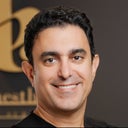Posted underEyelid Surgery q&a
Occulofacial Surgeons: Revision Eye Shape Following Too Strong Lateral Pull Temple Lift: Possible?
Sept.2010 a temple lift was done with too strong lateral pull: the lashline moved too high in the eye, certainly the lateral part. Surgeon then attempted July 2011 to release temple skin + subperiosteal release canthus. My eyes lost horizontal length without further improvement. I'm left with slanted catlike 'horizontally shortened' eyes, lashline high in the eye particularly laterally. I get a lot of comments daily from strangers;what technical possibilities are there still to improve?Thankyou!
Answers (9)
From board-certified doctors and trusted medical professionals
Dr. Kenneth D. Steinsapir, MD

Dr. Kenneth D. Steinsapir, MD
Oculoplastic Surgeon, Board Certified in Ophthalmology
Answer
Dr. A.J. Amadi, MD

Dr. A.J. Amadi, MD
Oculoplastic Surgeon, Board Certified in Ophthalmology
Answer
Dr. Mehryar (Ray) Taban, MD, FACS

Dr. Mehryar (Ray) Taban, MD, FACS
Oculoplastic Surgeon, Board Certified in Ophthalmology
Answer
Dr. Rian A. Maercks, MD

Dr. Rian A. Maercks, MD
Board Certified Plastic Surgeon
Answer
Dr. Sam Goldberger, MD
Dr. Sam Goldberger, MD
Oculoplastic Surgeon, Board Certified in Ophthalmology
Answer
Dr. Edwin Ishoo, MD
Dr. Edwin Ishoo, MD
Facial Plastic Surgeon, Board Certified in Otolaryngology – Head and Neck Surgery
Answer
Dr. Keshini Parbhu, MD
Dr. Keshini Parbhu, MD
Oculoplastic Surgeon, Board Certified in Ophthalmology
Answer
Dr. Jeffrey Zwiren, MD
Dr. Jeffrey Zwiren, MD
Board Certified Plastic Surgeon
Answer
Dr. Perry F. Garber, MD (retired)
Dr. Perry F. Garber, MD (retired)
Oculoplastic Surgeon, Board Certified in Ophthalmology
Answer
More Eyelid Surgery Questions
See all Eyelid Surgery Q&AWE SEND PRETTY
EMAILS
What’s trending? Who’s turning heads? Which TikTok myths need busting? We’ve got you. No fluff, no gatekeeping—just real talk. Get our free, unfiltered newsletter.